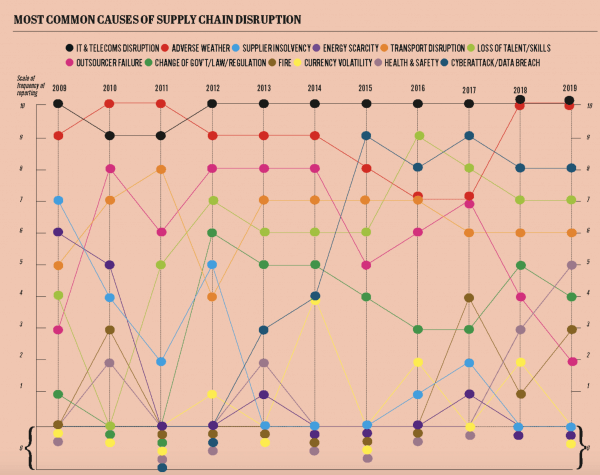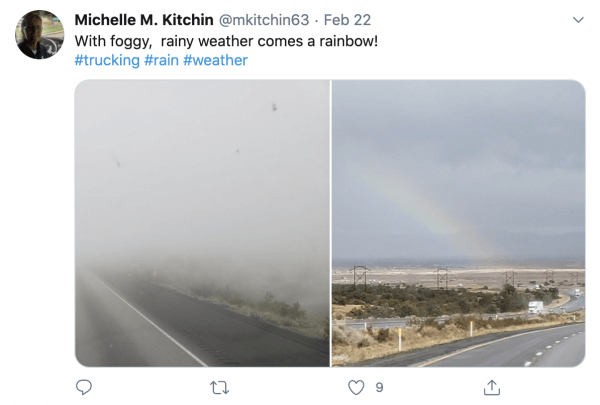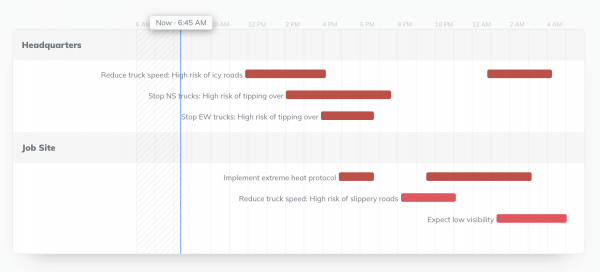Nearly every sector of the economy relies on the trucking industry to transport their goods and to ensure they get from point A to point B in a safe, reliable, and efficient manner.
In fact, almost $700 billion of goods are transported by truck every year.
But those shipments don’t always go smoothly. Even a 24-hour delay can have serious consequences for critical supplies such as medicine and food. Trucking also plays a key role in intermodal operations around the globe. Without it, goods would not be able to be transported from ports, rail yards, and airports to their final destination.
Yet despite the essential nature of the trucking industry, it’s still at the mercy of changing –– and extreme –– weather conditions.
Weather events have a huge impact on the industry:
- Weather is responsible for almost 25% of all truck delays
- Weather costs the trucking industry up to $3.5 billion a year
- Snow and ice are responsible for more than 50% of all weather-related delays
- The cost of delays in severe situations such as hurricanes or blizzards due to lost capacity can be more than $100 million a day
In 2019, adverse weather was also the second greatest source of supply chain disruption, accounting for 35.1% of disruptions.

Delays are not just caused by freak weather events such as hurricanes. Slight changes in temperature or everyday weather events such as heavy rain can throw trucking operations into turmoil if not managed properly.
Poor weather conditions can cause higher accessorials (fees added for additional services), including:
- Longer demurrage
- Deeper consumption of fuel
- More pick-ups and stop-offs
These accessorials lead to higher costs, which most companies can handle on a one-time basis. But ongoing, regular weather events quickly eat into the budget.
Freight transportation also doesn’t operate in isolation — it’s a key cog in the overall supply chain. Trucking companies can be hit by delays due to weather affecting other forms of transport, such as container ships or railcars. That’s why being able to adapt to the weather and prepare for the unexpected is crucial.
Trucking in cold weather
In early 2019, when 12 inches of snow fell in just a week in Minnesota, Iowa, and Wisconsin, winds were more than 50 MPH, and show drifts measured more than 10-feet tall, travel was nearly impossible. Portions of interstate highways in Minnesota and Iowa were closed for up to four days.
According to Certified Consulting Meteorologist Jim Foerster,
“These closures impacted, on average, more than 300,000 vehicles a day, and wreaked havoc on the transportation industry, leaving hundreds of truck drivers stranded in truck stops and off the road.”
Foerster also points out that severe weather occurrences like heavy precipitation, blizzards, and high winds are estimated to cause an average of 23% of all trucking delays, while heavy snowfall and ice can cause blocked roadways and traffic jams. He notes that the ripple effect of these delays soon becomes apparent to retailers and consumers.
The World Economic Forum’s Global Risks Report 2019 supports this claim. It notes that disruptions to the production and delivery of goods and services caused by environmental disasters, such as severe weather events, are up 29% since 2012.
It also observes that, “as environmental risks crystallize with increasing frequency and severity, the impact on global value chains is likely to intensify, weakening overall resilience.”
In current conditions, the default actions in response to weather warnings are either to reroute or wait out the storm.
If you choose to reroute, this adds significant time to the journey. If you choose to wait out the storm, you still have to pay the driver for the time they aren’t driving. You could also have to keep the reefer fuelled during downtime for certain types of shipments.
When you decide to wait out the storm, this has a knock-on effect on other shipments and it can take time to get back to normal capacity. This in turn can send rates soaring, both for the trucking industry and further along the supply chain.
In fact, there was a 22% year-over-year spot rate price increase following the harsh winter of 2014, which saw a range of serious weather events.
Maintenance, insurance, and other cold weather issues
Cold weather also has an effect on the smooth running of the truck. Colder temperatures can lead to:
- Lower tire pressure
- Heavier rolling resistance
- Higher idle time
All of the above result in more fuel usage and higher costs for your trucking operation.
According to one industry expert, it’s not the cold itself that brings the most potential for air system trouble – it’s the moisture that’s brought in with it when the compressor draws in air. Richard Nagel, director of marketing and customer solutions at Bendix’s charging group explains:
“If enough moisture makes its way through the air dryer, it creates the potential for condensation within the air tanks – and from there, it can travel downstream, affecting the braking system and other connected technologies.”
Another indirect impact of cold weather is on insurance premiums. If you operate on routes that have frequent weather events, this can push premiums up. If you don’t have the data at hand about weather events across your routes, then you will be unable to plan routes to keep your premiums at a minimum.
Without this data at hand, your drivers are also unprepared for the conditions they might face on the roads, which can lead to accidents. The more accidents your trucks have, the higher your insurance premium.
Effects of wet weather
The total economic cost of trucking accidents in the United States is more than $100 billion per year, with weather accounting for almost a quarter of these incidents. Of those accidents, nearly 75% occur on wet pavement, and almost 50% occur when it’s raining.
Heavy rain can cause localized urban flooding and leave roadways completely impassable. It’s also unsafe for drivers, especially when there is low visibility or on particularly dangerous stretches of road.
Heavy rain can start suddenly and not show up on long-range forecasts, meaning drivers have to react as they are on the road, either stopping or significantly slowing down. These situations add unexpected delays, compromise driver safety, and increase the likelihood of an accident occurring.
Some of the broad effects of disruption caused by wet weather include:
- Idle trucks waiting for water to recede from roads and loading docks
- Slow operations due to congestion, circuity, and backed up loading docks
However, current approaches to assessing the impact of wet weather assume that a road is fully operational and can be used as normal, or that it’s fully blocked. Other incorrect assumptions include:
- Traffic on open roads continues to flow smoothly, perhaps at a slightly reduced maximum speed
- Traffic conditions do not change over the course of the day, or seasonally
- Diversion routes, and changes (or not) to driver behavior as a result of the wet weather, are often assumed without any clear rationale
Keeping cool in warm weather
It’s not just cold weather that can throw a spanner in the works and slow operations; hot weather has just as much of an impact.
In the summer, tires and road surfaces can become incredibly hot and compromise the performance of tires. High heat can also lead to engine failure when driving at fast speeds. This means the driver needs to slow down to minimize damage to the truck and avoid a breakdown.
The situations add to the overall journey time.
Tire pressure increases in hot weather and having the incorrect pressure may lead to poor fuel mileage and sub-optimal vehicle handling, which can prove costly in terms of revenue.
If the temperature gets really hot, the driver can also suffer the consequences, even in an air-conditioned cab. The driver has to:
- Slow down
- Take regular breaks
- Stop to mitigate the effects of the heat
It’s not just the truck itself that comes under pressure in high temperatures — the cargo can suffer too. If you’re carrying a product that has to be maintained at a certain temperature, such as medicine or food, then your goods will be vulnerable in the heat.
You have to decide whether to implement additional temperature-control best practices, which are more costly, or run the risk of damaging your product. Some cargo just won’t be able to withstand true heatwave temperatures.
If you don’t plan for these situations in advance, rerouting your truck at the last minute, or holding off on making the journey, will likely be your only (very costly) options. That’s why it’s essential to be proactive and to plan ahead to mitigate any additional costs and minimize disruption.
This requires you to monitor the forecast and plan to avoid high-risk weather events. You also need to proactively adapt to the incoming weather conditions instead of constantly reacting in the moment. For example, you need to not only know there will be a massive storm tonight but, you need to know what the impact on traffic will be and what you should do instead.
Gain actionable trucking insights
Monitoring weather forecasts and receiving alerts for weather events will only get you so far. Having access to weather data, without any way of knowing how it’s influencing the road, the truck, and your cargo, will not provide enough insight to support drivers and shipping partners.
You have to decide what to do with weather data, and what parameters mean what actions in order to make a measurable impact on your operations. You need to see the overall picture to understand what action you should take, which can be far more complex than rerouting or halting operations.
For example, rain may be severe enough to cause your drivers to slow down, but this rain might only last an hour, or it might only be falling on a certain stretch of the highway. After that stretch of motorway or period of time, drivers can get back to full speed. The best option in this scenario would be to take the original route and adjust the ETA to account for the delay rather than stopping or rerouting.
Or certain stretches of road have specific characteristics, making them worse (or better) to travel on in certain conditions. For example, one stretch of road ices up more quickly than others leading to severe delays and treacherous conditions. Drivers don’t have to avoid the area altogether, they just have to take a different route.
It’s important to look at the whole picture. Maybe the particular weather event has passed, but what happens in the aftermath (or even preceding the event)? There may be more traffic and congestion, or mandatory speed limits may still be in place.
It’s also hard to make decisions when you are faced with unusual weather patterns, such as the fire tornado and dry thunderstorms we’ve seen this year. What exactly do these weather events mean for your business and how do they impact your operations?
Contrast the two different pictures below taken on one journey. They show very different weather scenarios along the same route. That’s why hyper-local forecasting is essential.

You need to be able to bring all the data together so you can get the necessary insight to take the best possible action. This requires weather intelligence.
Weather Intelligence: From insight to action
Weather data on its own isn’t enough; you need to know what that data means in the context of your business. Instead of looking at weather forecasts and deciding to reroute or stop operations due to bad weather, weather intelligence arms you with the insight that allows you to make more informed decisions.
A key part of weather intelligence for trucking is a road risk scoring system, which can help you navigate through and around treacherous roads. Real-time road risk information explains how trucks and other vehicles react to certain conditions. For example, brakes on newer trucks might be more sensitive to slippery conditions, which means drivers need to reduce speed more.
Road risk can also provide more information about the likelihood of accidents and therefore severe traffic delays, as well as a truck’s surroundings that can help ensure the route you schedule is safe and efficient. Drivers can be told about hazardous conditions far enough in advance to make schedule changes accordingly.
Tomorrow.io’s road risk scores range from low risk with little-to-no discernible weather-related risk right now to extreme risk.
Tomorrow.io’s weather intelligence platform
With so many changing and unexpected variables in the trucking industry, it’s very difficult to monitor all factors on a 24/7 basis. From the weather itself to traffic to road conditions, things are constantly changing across locations and routes. Automated predictive weather insights can help trucking managers and drivers improve efficiency, reduce unnecessary costs, and take advantage of new revenue opportunities
Tomorrow.io’s Insights Dashboard provides you with all the information you need to know about how the weather is going to affect your operations. This includes data for each of your locations on a daily and weekly basis.
In addition, instead of providing you with a forecast, you can see real-time recommendations on what to do so ensure you make the best possible decision at the right time. It provides the insights you need to know about before they happen, so your business can adjust and adapt to the changing conditions.

Tomorrow.io provides a customizable view of weather trends for more than 20 different weather parameters and map layers. You can also customize the alerts you receive and share the information and actions needed across your organization
Here are some of the invaluable insights you can get, and better outcomes you can achieve, with weather intelligence.
- Plan routes around the weather: reduce delays by understanding how the weather will impact any of your trucking routes several days ahead of time
- Get weather alerts in real-time: make decisions to re-route before it’s too late while providing up-to-date ETAs to your shipping partners
- Run a historical analysis of your trucking routes: see how routes have been affected by weather events in the past and then schedule routes in advance to meet ETAs
- Reduce the risk of damage: plan ahead for reduced speeds, greater stopping distances, and other hazards
- Improve driver safety: notify drivers of incoming weather like rain or snow, so they can take proactive action and avoid an accident
- Get hyperlocal route insights 24/7: receive by the minute updates for weather in specific areas so you can proactively re-route trucks
- Save money: optimize fuel, staffing, and labor costs, and lock in freight rates ahead of extreme weather events
- Optimize communication: use automated messaging to ensure a single source of truth for weather protocols
Tomorrow.io’s weather intelligence platform helps improve operational efficiency, reduce safety concerns, reduce unnecessary costs, or take advantage of new revenue opportunities.
